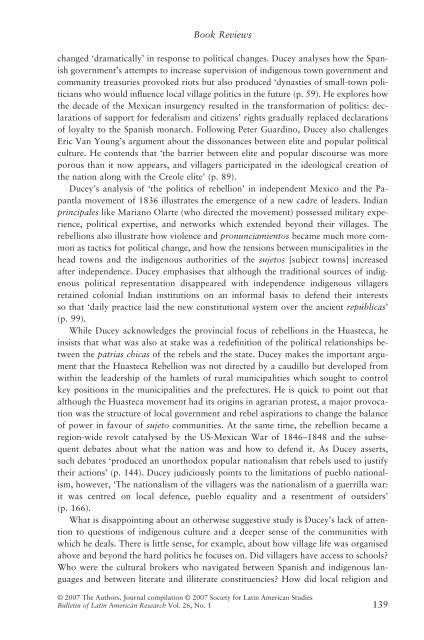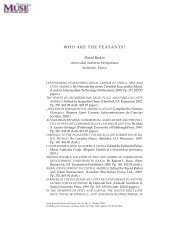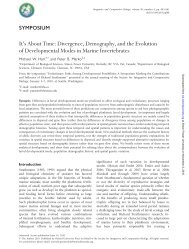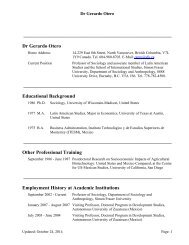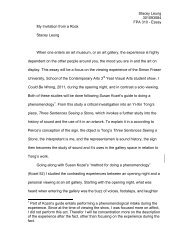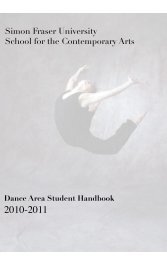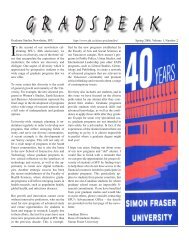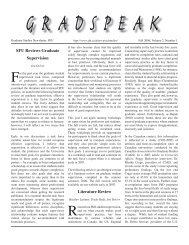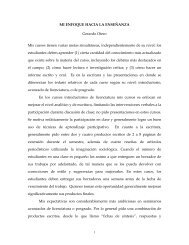Review of Mexico in Transition by Byron Crites
Review of Mexico in Transition by Byron Crites
Review of Mexico in Transition by Byron Crites
- TAGS
- transition
- byron
- crites
- cgi.sfu.ca
Create successful ePaper yourself
Turn your PDF publications into a flip-book with our unique Google optimized e-Paper software.
Book <strong>Review</strong>s<br />
changed ‘ dramatically ’ <strong>in</strong> response to political changes. Ducey analyses how the Spanish<br />
government ’ s attempts to <strong>in</strong>crease supervision <strong>of</strong> <strong>in</strong>digenous town government and<br />
community treasuries provoked riots but also produced ‘ dynasties <strong>of</strong> small-town politicians<br />
who would <strong>in</strong>fl uence local village politics <strong>in</strong> the future (p. 59). He explores how<br />
the decade <strong>of</strong> the Mexican <strong>in</strong>surgency resulted <strong>in</strong> the transformation <strong>of</strong> politics: declarations<br />
<strong>of</strong> support for federalism and citizens ’ rights gradually replaced declarations<br />
<strong>of</strong> loyalty to the Spanish monarch. Follow<strong>in</strong>g Peter Guard<strong>in</strong>o, Ducey also challenges<br />
Eric Van Young ’ s argument about the dissonances between elite and popular political<br />
culture. He contends that ‘ the barrier between elite and popular discourse was more<br />
porous than it now appears, and villagers participated <strong>in</strong> the ideological creation <strong>of</strong><br />
the nation along with the Creole elite ’ (p. 89).<br />
Ducey ’ s analysis <strong>of</strong> ‘ the politics <strong>of</strong> rebellion ’ <strong>in</strong> <strong>in</strong>dependent <strong>Mexico</strong> and the Papantla<br />
movement <strong>of</strong> 1836 illustrates the emergence <strong>of</strong> a new cadre <strong>of</strong> leaders. Indian<br />
pr<strong>in</strong>cipales like Mariano Olarte (who directed the movement) possessed military experience,<br />
political expertise, and networks which extended beyond their villages. The<br />
rebellions also illustrate how violence and pronunciamientos became much more common<br />
as tactics for political change, and how the tensions between municipalities <strong>in</strong> the<br />
head towns and the <strong>in</strong>digenous authorities <strong>of</strong> the sujetos [subject towns] <strong>in</strong>creased<br />
after <strong>in</strong>dependence. Ducey emphasises that although the traditional sources <strong>of</strong> <strong>in</strong>digenous<br />
political representation disappeared with <strong>in</strong>dependence <strong>in</strong>digenous villagers<br />
reta<strong>in</strong>ed colonial Indian <strong>in</strong>stitutions on an <strong>in</strong>formal basis to defend their <strong>in</strong>terests<br />
so that ‘ daily practice laid the new constitutional system over the ancient repúblicas ’<br />
(p. 99).<br />
While Ducey acknowledges the prov<strong>in</strong>cial focus <strong>of</strong> rebellions <strong>in</strong> the Huasteca, he<br />
<strong>in</strong>sists that what was also at stake was a redefi nition <strong>of</strong> the political relationships between<br />
the patrias chicas <strong>of</strong> the rebels and the state. Ducey makes the important argument<br />
that the Huasteca Rebellion was not directed <strong>by</strong> a caudillo but developed from<br />
with<strong>in</strong> the leadership <strong>of</strong> the hamlets <strong>of</strong> rural municipalities which sought to control<br />
key positions <strong>in</strong> the municipalities and the prefectures. He is quick to po<strong>in</strong>t out that<br />
although the Huasteca movement had its orig<strong>in</strong>s <strong>in</strong> agrarian protest, a major provocation<br />
was the structure <strong>of</strong> local government and rebel aspirations to change the balance<br />
<strong>of</strong> power <strong>in</strong> favour <strong>of</strong> sujeto communities. At the same time, the rebellion became a<br />
region-wide revolt catalysed <strong>by</strong> the US-Mexican War <strong>of</strong> 1846 – 1848 and the subsequent<br />
debates about what the nation was and how to defend it. As Ducey asserts,<br />
such debates ‘ produced an unorthodox popular nationalism that rebels used to justify<br />
their actions ’ (p. 144). Ducey judiciously po<strong>in</strong>ts to the limitations <strong>of</strong> pueblo nationalism,<br />
however, ‘ The nationalism <strong>of</strong> the villagers was the nationalism <strong>of</strong> a guerrilla war:<br />
it was centred on local defence, pueblo equality and a resentment <strong>of</strong> outsiders ’<br />
(p. 166).<br />
What is disappo<strong>in</strong>t<strong>in</strong>g about an otherwise suggestive study is Ducey ’ s lack <strong>of</strong> attention<br />
to questions <strong>of</strong> <strong>in</strong>digenous culture and a deeper sense <strong>of</strong> the communities with<br />
which he deals. There is little sense, for example, about how village life was organised<br />
above and beyond the hard politics he focuses on. Did villagers have access to schools?<br />
Who were the cultural brokers who navigated between Spanish and <strong>in</strong>digenous languages<br />
and between literate and illiterate constituencies? How did local religion and<br />
© 2007 The Authors. Journal compilation © 2007 Society for Lat<strong>in</strong> American Studies<br />
Bullet<strong>in</strong> <strong>of</strong> Lat<strong>in</strong> American Research Vol. 26, No. 1 139


